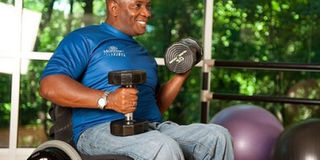Exercises for those with limited mobility

If any activity causes severe pain or discomfort, stop immediately and seek help. It is always best to exercise with supervision and ask for help if needed. File photo
It sounds so easy. Eat less and exercise more, and you will lose weight. Seems simple enough, but if you are an individual experiencing a physical disability, you may find yourself caught in a vicious cycle of limited mobility and decreased physical activity, accompanied by weight gain.
The more weight you gain, the harder it becomes to exercise. The more inactive you become, the more weight you gain. If you find yourself in this kind of situation, take heart. You can break the cycle and lose weight.
Kevin Onekalit, a trainer at Seascallop Restaurant in Kamwokya, says exercising for the disabled goes hand in hand with an individual’s physical formation.
Exercises could be an option of reducing disability as it will make you stronger and more firm. Loyce Naula, an orthopedist at Kumi Hospital, says exercising is the best therapy as it helps a person live a normal life.
Onekalit and Naula recommend the following exercises for those with limited mobility.
Cardiovascular exercises.
Naula says these exercises raise your heart rate and increase your endurance. They can include walking, running, cycling, dancing, tennis, swimming and water aerobics.
“Many people with mobility issues find exercising in water especially beneficial as it supports the body and reduces the risk of muscle or joint discomfort. Even if you are confined to a chair or wheelchair, it is still possible to perform cardiovascular exercise,” she says.
Strength training exercises
These involve using weights or other resistance to build muscle and bone mass, improve balance, and prevent falls. If you have limited mobility in your legs, your focus will be on upper body strength training. Similarly, if you have a shoulder injury, for example, your focus will be more on strength training your legs and core.
“Strength training is also important for improving balance and stability,” Naula says.
Flexibility exercises
Onekalit says these help reduce pain and stiffness. Some of these include stretching exercises, which can be done either seated or on the floor. Doing chair yoga is also recommended. In case your body movement is limited due to extreme exhaustion or body pains, make use of aerobics and strength training exercises.
Seated dancing
This can be done on your bed, in a wheel chair or on an exercise ball if you are able to balance. Select a fast moving song and dance randomly. “Swing your hands, rotate your waist and make sure all your body parts are in motion,” Onekalit advises.
Air-punching
This can be done either seated or standing. For effectiveness, it should be done a little fast, without fully extending your elbow joint, and then pull it back in as fast as you can. Do anywhere from 10 to 30 reps.
Stick with it
It takes about a month for a new activity to become a habit. Write down your reasons for exercising and a list of goals and post them somewhere visible to keep you motivated. Focus on short-term goals, such as improving your mood and reducing stress, rather than goals such as weight loss, which can take longer to achieve. It is easier to stay motivated if you enjoy what you are doing, so find ways to make exercise fun. Listen to music or watch a TV show while you workout, or exercise with friends.
Basic Tips and Tools to Get You Started
Fitness.mercola.com, an online platform gives the following basic tips and tools you will need to perform seated exercises:
• A stable armless chair to sit in. Make sure it doesn’t have wheels or slide easily, unless the exercise actually calls for a chair with wheels
• A resistance band, two Frisbee rings or small (child sized) hula hoops, and hand weights of suitable weight based on your current strength
• Optional items you may want if and when you’re ready to increase the difficulty of the exercise: an exercise ball, wrist, and/or ankle weights
• Remember to maintain good posture throughout each exercise, and engage your core by imagining your sternum moving back towards your spine
• If you are frail and/or have poor balance, be sure to perform any and all exercises with supervision and/or assistance.




